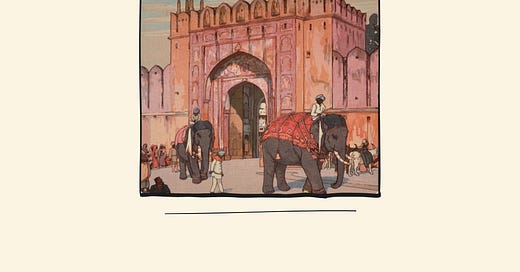Greetings, fellow wanderers. Thank you for letting me into your inbox. I hope you can walk with me today as we visit some beautiful art from the 1930s- India via Japan (or is it the other way round?); and pause to think of our devices, our brains and their dynamic and fraught relationship, and enjoy a textured sense of slow luxury.
Shall we?
Light As A Living Thing: Of travellers and Japanese woodblocks.
Friday Find: An Alluring Essence of Summer
Device Management: Phones chains, brain-rot, going light.
With: The one that ended it all, bots run the farm, AI etiquette, birding detectives.
1. Light as a living thing.
Nearly 95 years ago, a man and his son left Tokyo, Japan and travelled for four months through India.
That man was Hiroshi Yoshida, now widely acknowledged as one of the finest Japanese artists in the first half of the 20th century. A master of the shin-hanga (’new print’) movement, Yoshida had established himself as an artistic bridge, blending Western influences with traditional Japanese woodblock techniques. His trip through India produced 32 exquisite woodblock prints. In recent years, they have found their way back into public consciousness.
Their gentle charm and peaceful calm, the interplay of pastel colours and light, colour applied in near-translucent washes, an atmospheric sense of time…seem perfectly suited to capturing social media imagination.
“Hiroshi’s prints breathe coolness, invite meditation, and set a soft, peaceful mood.”
Perfection.
Hiroshi Yoshida was first a watercolour and oil painter, having trained in the Western style. It was only in his 40s that he was lured into woodblock printing. Deeply immersed in it, and masterful at the craft, he believed the process must be owned entirely by the artist. Traditionally, it was a collaborative effort between the artist, the carver, the printer, and a publisher.
Yoshida became known for demanding complete control, from start to finish. His obsessive standards would decide if his prints would bear his signature and the jizuri (self-printed) mark.
As he once said, “If a print does not come out as I wish, I destroy it. Only those prints which satisfy me are signed.”
Such intimate understanding of the techniques also led to series where the same scene was coloured differently- memorably his ‘Inland Sea’ series of sailing boats. This was an approach he would carry across the world, including the Matterhorn, Sphinx, and the Taj Mahal.
Day & Night.
Nearly a century ago India was surely a logistical and cultural challenge to traverse, as many still feel today. [If Yoshida & his son Toshi were alive they too would have, I'm sure, subscribed to that meme, "India is not for beginners”!]
From November 1930, Hiroshi Yoshida and Toshi embarked on a gruelling four-month expedition. They traversed Agra, Delhi, Jaipur, Lahore, Madurai, Ellora, and Varanasi (then Rangoon & Singapore). The son later shared that the trips were meticulously plotted, recalling their exhausting schedule. "It was no leisurely tour. By day, Father sketched relentlessly; by night, we raced to new destinations. The heat, the crowds-it was exhausting, but he’d say, ‘Beauty demands sacrifice.’"
They traveled primarily by night train to maximise daylight hours for drawing & painting- all because Yoshida believed that truly capturing India's essence required experiencing its changing light. It's not surprising then, that some of the most well-received work from the trip was his Taj Mahal series.
Toshi later recounted his father’s determination to capture the monument under moonlight, waiting overnight alongside local guides and guards who shared stories of its history

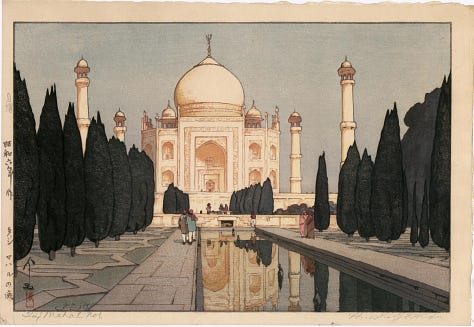

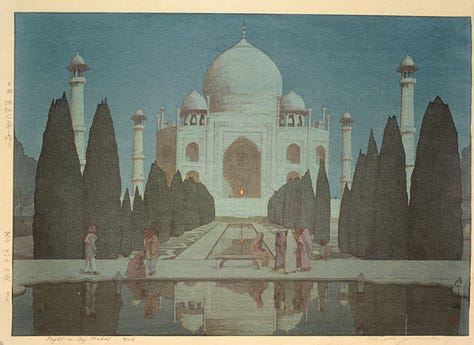


“I have always had a desire to travel. I wanted to see the world, to see the great mountains, the beautiful rivers, and the different peoples. I wanted to paint them as I saw them.”
Beauty demands sacrifice.
Yoshida's perfectionism and adventurous spirit defined his India prints. He employed advanced techniques like betsuzuri (multi-block printing) to layer colours and create subtle tonal shifts that captured the unique quality of Indian light. This painstaking process allowed him to achieve remarkable depth and luminosity, where the architecture seems to breathe with the light.

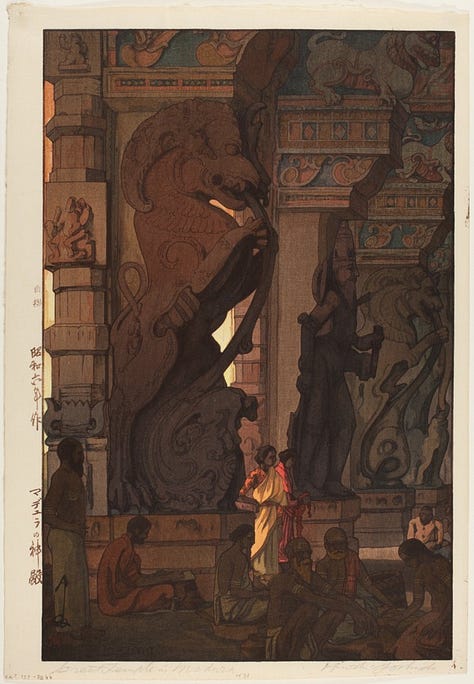
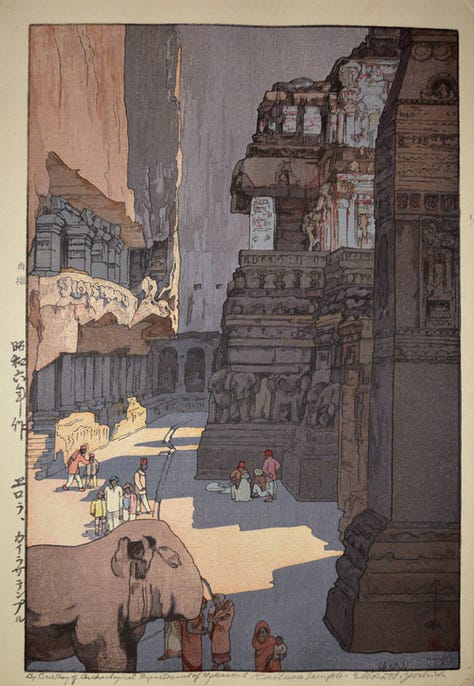

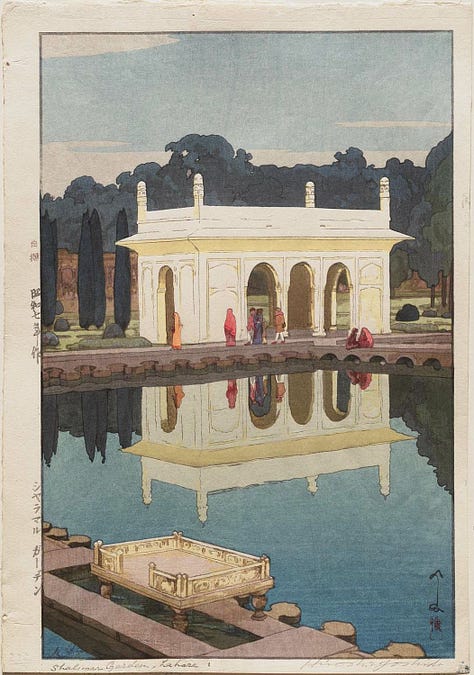

Trained in Western oil painting, deeply rooted in Japanese aesthetics, a genius with light, Yoshida created these images that were both technically masterful and poetically evocative. I can barely begin to understand the skill, but can maybe imagine the scene.
Its 1930, a cold winter night in Agra. Near a moonlit Taj Mahal, two men from a distant land wait patiently for the light to be just so.
Their love for their craft echoes, a century on.
“From my father, I learned that light is a living thing, and that the artist must be patient to capture its true form.”
Addendum
Ukiyo-e. A traditional Japanese art form dating back to the 17th century, Ukiyo-e ("pictures of the floating world”) used intricate woodblock prints to capture the fleeting nature of life. ‘Shing-hanga’ revived ukiyo-e traditions in the 20th century, incorporating Western influences and contemporary subject matter.
Woodblock printing. If, like me, you do not really understand the craft of woodblock prints… well, then you are like me, is all. But you could take a look at this video to see how (seemingly effortlessly) the printer uses the block to make a print. Of course, this raises the question of the block itself. Ok then- a glimpse of that, in this video, a nod to the Chinese form centuries ago, that eventually gave shape to Japanese woodblock printing. Or here, the carving part of a series of videos recreating the ‘Great Wave’ image we are all likely familiar with. There is a certain, dare I say, zen quality to the printing, especially in the first video and this one, where no music interferes with the sounds of the artist brushing, scrubbing, rolling, and printing.
The Incredible Yoshida Artist Family: Hiroshi was part of (and greatly furthered) a fine legacy of Yoshida artists. He established the Yoshida Studio in 1925, as his wife Fujio developed into one of the leading modern women artists of the time.
Toshi, that travelling companion in moonlight Indian nights, moved beyond his father’s romantic style to brightly illuminated modern realism, abstraction in oils, woodblock printing, and illustrating children’s books. His wife, Kiso worked with traditional Japanese sand painting and woodblock prints.
Their son, Tsukasa Yoshida is the director of the Yoshida Hanga Academy, and produces “surprising modern woodblock prints that blend symbolism and realism”. His wife Kiyoko is a performance artist who plays the Celtic harp. Their daughter, Aya, is a woodblock and mixed media printmaker with a “unique, fresh, poetic style of her own”.
But separately, Hiroshi and Fujio’s other son Hodaka, became an eminent artist himself- focussing on abstract art, oils, woodblock prints, pioneering in new techniques like copper-etching; as well as avant-garde poetry, photography, sculpture. His wife too was an abstract artist, and their daughter Ayomi Yoshida has created post modern works for many decades now, both with woodblock and in large-room installations.
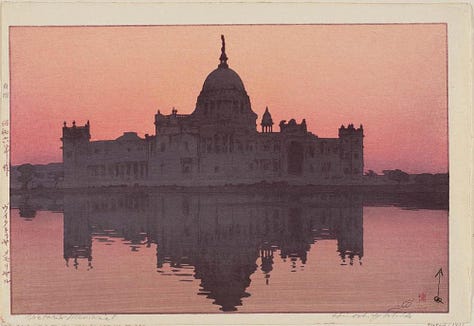

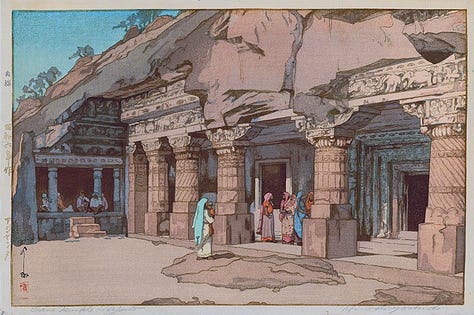

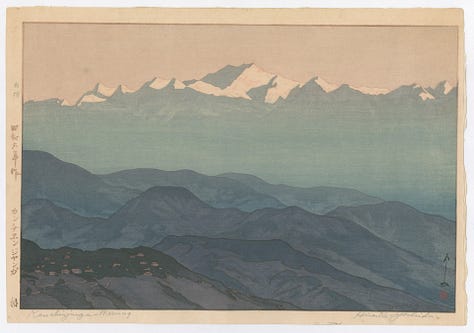
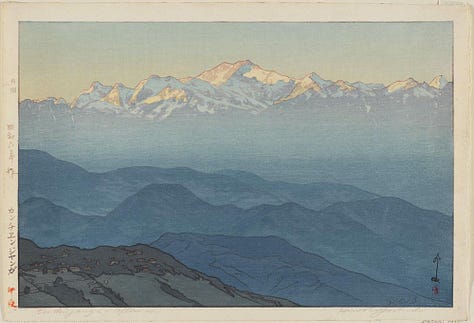
Sources · Images here, here, here · Asian Arts · Yokogao Mag · Encyclopaedia of woodblock ·
2. Friday Find: The Essence Of Summer
A warm and languid vacation. An indulgent summer. The slow life.
Casual luxury. Subtlety.
The allure of control. An irresistible evening. A subtle and uncertain sexual tension.
Gucci has crafted a campaign drawing on ‘the essence of an Italian summer’.
I feel stray caresses of Emerald Fennel’s Saltburn (sans the dark undertones), as slivers of a classic Italian holiday seep into in this night time bedroom. Three friends lie casually draped on the bed, awash in their youthful, assured charm. One can’t help but wonder where this might go.
If you care to check, they say these friends are pulled together by a “shared desire for escape and the quiet thrill of discovery”, but you didn’t need the copy to tell you that. The storytelling drips with that bubbling passion; the promise and the possibilities- apparent and imagined- are palpable.
“The new Gucci Lido campaign, featuring Daisy Edgar-Jones, Aliocha Schneider, and David Jonsson, becomes a living tableau as friends gather by the sea where time stretches and the usual pace of life gives way to something grounded, yet full of possibility.”
The alluring film is is accompanied by the photographs of Jim Goldberg and his signature use of written reflections.




Director: rubberband. · Smuggler · Martina Fabris · Jermine C ·
3. Device Management
Does it sometimes feel like you're almost chained to your phone, being led along a little haplessly, occasionally willingly, often irresistibly, sometimes mindlessly? Led along a meandering path by a device and all the wonders that it holds, with way less control than you would like.
I know I do.
I’ve sometimes described these little pocket computers of ours as smart devices that make us smarter and occasionally dumber. (You might want to swap the ‘occasionally’ in that sentence, or not!)
For no particular reason, this came up again when, despite endeavouring to use my device(s) mostly for noble purposes— such as the research of this esteemed publication or some perceived personal edification— it still sometimes feels towards the end of a day that I am surgically attached to it.
It reminded me of an award-winning short film from a couple of years ago that personified exactly what I’m describing. It’s not dark and dystopian, nor long; give it a look. It has a cheery, even cutesy vibe and style, that contrasts with the powerful theme. The story of a young boy led around by his phone is all too familiar. Maybe you’ve seen it , maybe you’ve noticed it, maybe you’ve been that boy.
· by Tobias Schlage & Brent Forrest ·
Rotten.
In 2024, the Oxford Dictionary’s chosen word of the year was ‘brain rot’. Don’t dismiss it as just another piece of generational lingo. The term itself is actually the better part of two centuries old, coined by Henry David Thoreau. “Why level downward to our dullest perception always, and praise that as common sense?” he asked his fellow English in 1845.
"For Thoreau, 'brain-rot describes what happens to our minds and spirits when we suppress our innate instincts for curiosity and wonder, and instead resign ourselves to the unreflective habits we observe all around us— habits of fitting in, getting by, chasing profits, chatting about the latest news.”
It is now re-contextualised in the digital age to describe a dilution of intellectual faculties, driven by excessive consumption of trivial or unchallenging content, particularly on social media. Led by our devices.
I extend the scope of this beyond flashy TikToks and reels. Beyond algorithm-fuelled doom scrolling, cynically targeted news and opinions. It's all of that, but it's also just the sheer volume, the infinite content loop that life has become. Our intent is often noble, but in the search for the meaningful or the wonderful, we find ourselves wading through a sea of sludge.
Of course, devices are mere gateways. (I use ‘mere’ loosely). The apps, platforms and social media we use have fundamentally changed /distorted the way we live and interact with the world around us, or thousands of miles away from us.
We cannot lay all the blame for this on devices, which are incredibly powerful, and incredibly useful. We cannot lay it all at the door of platforms and corporations that are self-admittedly only here for profit. And we cannot deposit all the blame for this at the feet of human beings, especially young people, or digital natives; this is the only life they know.
But brain rot is real. The incredible volume of noise ensures we are being swept along more often than trodding paths of our own. In this context, it was also interesting for me to read a little bit more about the Light Phone. The latest model might be worth a look.
Going light.
If you have never heard of it, this is a phone intended to foster intentionality. Stripped of much ‘smartness’, yet no dumb phone. In finding that tricky balance, it appears Light Phone III comes the closest.
As this review on the The Verge puts it, “The idea of the Light Phone is to turn “using your phone” into a thing you do on purpose, not absentmindedly whenever your brain is unoccupied for three seconds. Having instant, always-on access to everything is not a good thing, and the Light Phone takes it away. I have used the Light Phone III less than any other phone I’ve ever reviewed, and that is a great thing.”
“The value of the Light Phone is not necessarily in any specific feature, but rather the experience we call going light. In our hyper-connected lives, going light is a profound shift.”
The idea is appealing. Equally, the instinctive apprehension- even fear- of not having it all at one’s fingertips, is all too real. The latest model looks to reduce some of that (look, it has a camera!) But it is Light’s approach to intentionality, obsolescence, user freedom, utility and optionality that truly holds allure.
User thoughts:
“It’s like the fog in my head has finally been cleared out and I’m seeing and enjoying the world anew.”
“The ‘what ifs’ can be pretty overwhelming when considering the move, but honestly, l’ve not missed anything.”
“It’s really refreshing to not be sold something all of the time.”
Masala Peanuts
(where I share stories or tidbits I find interesting).
Read: “You are, by the nature of sharing these automated words, signalling to me that you care less about my time and attention than you do your own.“ Its just bad etiquette to communicate using AI.
Read: “It’s not just the bots that are gaming the algorithms through mass amplification. It’s also the algorithms that are gaming us. We’re being subtly manipulated by social media.” You may or may not have heard of bot farms and how they can manipulate internet traffic and social movement. But you should read this.
Remember: On May 6, 2004 TV sitcom "Friends" aired the series finale, "The Last One", also known as "The One Where They Say Goodbye".
Add To Queue
-watchlist, playlist, readlist- :: stuff on my radar
The Residence. A murder mystery in the White House that I appreciate more for its intent and ambition- being a quirky, amusing whodunnit with an oddball character— than its final product. Which was a quirky, amusing, occasionally repetitive whodunnit with an oddball character. And oh, birds. Lots of birds. On Netflix.
"Devote your attention to what you know, in your heart of heart, really matters: meaning, beauty, love, wonder, and gratitude for this earth.” _Henry David Thoreau, 1835.


